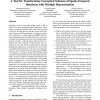Free Online Productivity Tools
i2Speak
i2Symbol
i2OCR
iTex2Img
iWeb2Print
iWeb2Shot
i2Type
iPdf2Split
iPdf2Merge
i2Bopomofo
i2Arabic
i2Style
i2Image
i2PDF
iLatex2Rtf
Sci2ools
DBA
2004
2004
A Tool for Transforming Conceptual Schemas of Spatio-Temporal Databases with Multiple Representation
Nowadays, classical conceptual models (such as ER or UML) are used for designing database applications. These classical conceptual models usually come with associated CASE tools assisting the user from the creation of the conceptual schema until the generation of a physical schema for a relational or an object-relational DBMS. However, when developing spatial or temporal databases such classical models are inadequate since they do not consider spatiotemporal concepts. Although spatial and/or temporal extensions have been proposed for these models, such extensions do not cope with the requirements of advanced geographical applications, in particular, they do not cope with multiple representations of the same real-world phenomenon. In the context of the European project MurMur we developed a conceptual model called MADS coping with spatio-temporal information having multiple representations. Typical examples of multiple representation arise with multi-scale or time-varying information. ...
| Added | 30 Oct 2010 |
| Updated | 30 Oct 2010 |
| Type | Conference |
| Year | 2004 |
| Where | DBA |
| Authors | Mohammed Minout, Christine Parent, Esteban Zimányi |
Comments (0)

